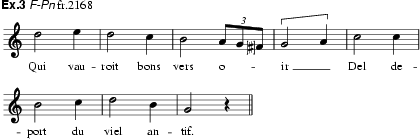
(Lat. cantus gestualis).
A type of epic poetry in which the recitation of the tale is unfolded with the help of simple melodic material, necessarily simple so that the attention of the listener may be directed towards the dramatic delivery of the story. The poems, which may be very long, are divided into sections called laisses or tirades, each having its own formula. The constant repetition of the same melodic phrase is comparable with the form of the litany. All the surviving examples, about 100 in number, are northern French in origin and mostly from the 12th century. Perhaps the most famous example is the Chanson de Roland, which consists of nearly 300 laisses. The form of the chanson de geste is described in the following terms by the theorist Johannes de Grocheio (see Seay):
The verse in gestual cantus [cantu gestuali] is that which is made up of many versicles. The versicles end on the same poetic rhyme. In a particular cantus it may close with a versicle not rhyming with the others, just as in the chanson de geste which is said to be by Girade de Viana. The number of verses in a gestual cantus is not fixed, but is dependent on the amount of material and the will of the composer. Also, the same melody ought to be repeated in all the versicles.
Strictly speaking, the reiteration of the melodic formula is true of each laisse but not of the poem as a whole. The subject matter deals mainly with deeds of heroism or, according to Grocheio, the life of Charlemagne or lives of the saints. Two religious chansons de geste survive, one a Passion and the other a life of St Léger (F-CF 240 ff.110 and 159v), but neither is notated.
No chanson de geste has survived with its music fully notated, which is scarcely surprising, since the short melodic formulae would not have been difficult to memorize; two formulae survive, however, as quotations in other works. In Adam de la Halle’s pastoral play Le jeu de Robin et de Marion one character, Raimberge, quotes a single laisse (beginning as shown in ex.1) which constitutes the total material for the section. A second quotation is found in Thomas de Bailleul’s Bataille d’Annecin (GB-Lbl Roy.20 A.xvii, f.177). Under each group of ligatures appears the syllable ‘in’, the significance of which is obscure (ex.2).


Something of the form of the complete chanson de geste can be seen in existing examples of the chante-fable. The main difference between the two is that the chante-fable alternates prose and verse sections, but the latter are effectively in the same form as a chanson de geste type laisse. The only surviving example of the chante-fable is Aucassin et Nicolette (F-Pn fr.2168; ex.3). Apart from its entertaining quality the chanson de geste also seems to have had a didactic purpose. Grocheio suggested that it was suitable for reciting to old people or workers resting from their labours, so that by contemplating misfortunes their own hardships would be easier to bear.

MGG2 (H.-H.S. Räkel)
E. de Coussemaker: ‘Le jeu de Robin et Marion’, Oeuvres complètes du trouvère Adam de la Halle (Paris, 1872/R), 345–412
F. Gennrich: Der musikalische Vortrag der altfranzösischen chansons de geste (Halle, 1923)
M. Roques, ed.: Aucassin et Nicolette, Les classiques français du Moyen Age, xli (Paris, 1925, 2/1929/R)
F. Gennrich: Grundriss einer Formenlehre des mittelalterlichen Liedes (Halle, 1932/R), 40ff
E. Rohloff, ed.: Der Musiktraktat des Johannes de Grocheo (Leipzig, 1943, 2/1972)
J. Chailley: ‘Etudes musicales sur la chanson de geste et ses origines’, RdM, xxvii (1948), 1–27
J. Chailley: ‘Autour de la chanson de geste’, AcM, xxvii (1955), 1–12
R. Louis: ‘Le refrain dans les plus anciennes chansons de geste et le sigle AOI dans le Roland d’Oxford’, Mélanges de linguistique et de littérature romanes à la mémoire d’István Frank (Saarbrücken, 1957/R), 330–60
J. van der Veen: ‘Les aspects musicaux des chansons de geste’, Neophilologus, xli (1957), 82–100
F. Gennrich, ed.: Adam de la Halle: Le jeu de Robin et de Marion (Frankfurt, 1962)
A. Seay, trans.: Johannes de Grocheo: Concerning Music (De Musica) (Colorado Springs, 1967, 2/1973)
J. Dufournet: Aucassin et Nicolette (Paris, 1973)
La chanson de geste et le mythe carolingien: mélanges René Louis (Saint-Père-sous-Vézelay, 1982) [incl. J. Chailley: ‘Du “Tu autem” de “Horn” à la musique des chansons de geste’, 21–32]
J. Stevens: Words and Music in the Middle Ages (Cambridge, 1986), esp. 222–34
Chansons de geste in Deutschland: Schweinfurt 1988
E.A. Heinemann: L’art métrique de la chanson de geste: essai sur la musicalité du récit (Geneva, 1993)
IAN R. PARKER